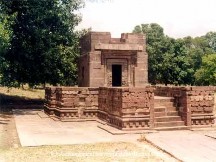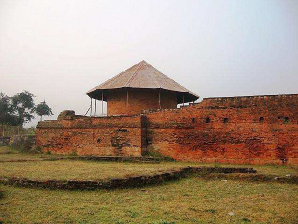6.3 Temple Architecture
Seated Buddha, Sarnath
Gupta period marks the beginning of Indian temple architecture.
Manuals were written regarding how to form temples. The Gupta temples were of five main types:

1) Square building with flat roof shallow pillared porch; as Kankali Devi temple at Tigawa and the Vishnu Varaha temples at Eran. The nucleus of a temple – the sanctum or cella (garbhagriha) – with a single entrance and a
porch (Mandapa) appears for the first time here.
2) An elaboration of the first type with the addition of an ambulatory (paradakshina) around the sanctum sometimes a second storey; examples the Shiva temple at Bhumara(M.P.) and the lad- khan at Aihole. Another noteworthy example is Pārbati temple at Nachnakuthara (M.P.).
3) The square temple with a low and squat tower
(shikhara) above; pillared approach, a high platform at the base; notable examples are the
Nachnakuthara
Dasavatara temple (Deogarh Jhansi) and the brick temple at Bhitargaon Kanpur. The most unique achievement of this stage was "Curvilinear tower" i.e. "Shikhara". "Nagara Style " temple making is said to be the success of third stage of temple making.

4) Rectangular temple with an apsidal back and barrel-vaulted roof above such as the Kapoteswara temple at Cezarla(
Krishna district).
5) Circular temples with shallow rectangular projection at the four cardinal faces; the only monument exemplifying the style is the Maniyar Math shrine at Rajgir, Bihar.
(The fourth and fifth types appear to be survivals/adaptations of the earlier forms and do not appear to have much influenced subsequent development).
